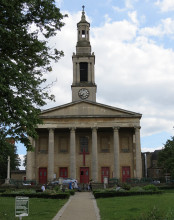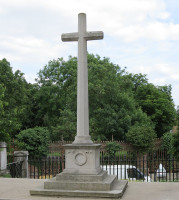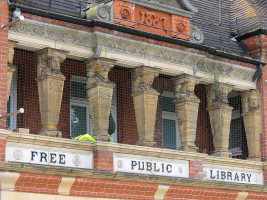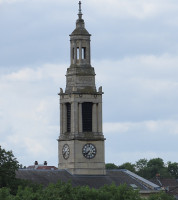 St Luke's, West Norwood.
St Luke's, West Norwood.
St Luke’s Church, West Norwood, is a Commissioners Church in South London, conveniently reached by train from Victoria Station, and is noted here for its interesting mosaics.
St Luke’s was erected between 1822 and 1825to the design of the architect Francis Bedford, one of four so-called Waterloo Churches in Lambeth, and, I think, the only Classical church in the Norwood area. The Church Building Commissioners, set up in 1818 had money to support hundreds of churches in metropolitan areas, but only if they kept to a strict budget, so like many of their works, St Luke’s is rather blocky, to accommodate a large congregation at modest cost,, built in a mix of brick and stone. The glory of the Church is the view from the gardens in front: a great hexastyle (six-pillared) Corinthian portico with a blank pediment, and behind that, a tall tower of several stages with two sets of pillars. For reasons of economy, the Church was originally somewhat austere inside. However, the Victorian Gothicist and prominent church architect G. E. Street completely redesigned the interior from 1870, and put in the round arches on leafy pillars, the barrel-shaped or waggon roof, the use of red and white alternating brick and stone. At one time there was stained glass and two wall paintings, but these were removed to leave a quite pale interior with white painted walls and only the trimmings round the edges as Street had them.
Disposition of mosaics on Pulpit and approach, and three panels.
There is only a single monument inside the Church, a plain white wall tablet to the Revd. Charles Turner. But we have come to see the mosaics, which consist of several panels on the wall of the pulpit and the long approach to it. There are two panels with figures, of which St Luke is the one with the scroll, this being his emblem, or more usually a book, as he wrote the Gospels. The other panels, seven or eight in number, have designs of simplified flowers and Biblical iconography – a Dove, a Lamb of God, three Fishes, and a sunburst.
The two figures stand on blue and white chequered floors, and have beige-yellow backgrounds, similar to Byzantine figures against gold mosaic, but here we have encaustic tile mosaics rather than the glittery and reflective Salviati mosaics from Venice. The only exception is the black lines around the edges and drapery folds of the figures, which are traditional Italian mosaics cut specifically for this purpose. The style of the faces, treatment of hands and feet put these as 20th Century works, and the setting of the mosaics, their angles and arrangement, are a conscious look back to Classical antiquity rather than anything typical Victorian. The artist was interested in overall effect rather than draughtsmanship, a nd the figure of St Luke has his feet oddly oriented if his legs were positioned as implied by the drapery. The hands, however, are simple but nicely pictured, and the faces are again rather simpler than expected – but the intent is to provide figures which can be distinctly seen from the pews rather than be subjected to close inspection. The other panels are also simple, but effectively designed so as to make the most of the allegorical animals within, and again, clear to be seen by the audience.

 War memorial, and Free Library.
War memorial, and Free Library.
Back outside the Church, we may note the War Memorial by the entrance: a traditional Churchyard cross with inscriptions, wreath carved on the base, but no other ornament. Just across the road is the vast West Norwood Cemetery, one of the ‘magnificent seven’ cemeteries put up in early Victorian times to resolve the issue of limited burial space in the City. And we may note en passant the Free Public Library on the other side of the road, a terra cotta and brick effort with a line of steles – pillars with proportions of the human body and human heads (for more like this, see the Caryatid page), representing great literary figures, including Shakespeare; the building is dated 1887.
 Spire of St Luke's, characteristic work of Francis Bedford.
Spire of St Luke's, characteristic work of Francis Bedford.
With many thanks to the Church authorities for permission to show pictures of the mosaics inside St Luke's; their website is http://www.stlukeswestnorwood.org/.
Introduction to Victorian Mosaics in London
Monuments in some London Churches // Churches in the City of London // Introduction to church monuments
Angel statues // Cherub sculpture
Visits to this page from 15 June 2014: 5,135